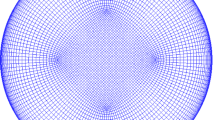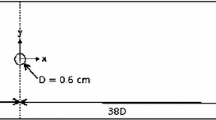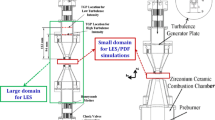Abstract
The highly turbulent flow occurring inside gas-turbine combustors requires accurate simulation of scalar mixing if CFD methods are to be used with confidence in design. This has motivated the present paper, which describes the implementation of a passive scalar transport equation into an LES code, including assessment/testing of alternative discretisation schemes to avoid over/undershoots and excessive smoothing. Both second order accurate TVD and higher order accurate DRP schemes are assessed. The best performance is displayed by a DRP method, but this is only true on fine meshes; it produces similar (or larger) errors to a TVD scheme on coarser meshes, and the TVD approach has been retained for LES applications. The unsteady scalar mixing performance of the LES code is validated against published DNS data for a slightly heated channel flow. Excellent agreement between the current LES predictions and DNS data is obtained, for both velocity and scalar statistics. Finally, the developed methodology is applied to scalar transport in a confined co-axial jet mixing flow, for which experimental data are available. Agreement with statistically averaged fields for both velocity and scalar, is demonstrated to be very good, and a considerable improvement over the standard eddy viscosity RANS approach. Illustrations are presented of predicted time-resolved information e.g. time histories, and scalar pdf predictions. The LES results are shown, even using a simple Smagorinsky SGS model, to predict (correctly) lower values of the turbulent Prandtl number in the free shear regions of the flow, compared to higher values in the wall-affected regions. The ability to predict turbulent Prandtl number variations (rather than input these as in combustor RANS CFD models) is an important and promising feature of the LES approach for combustor flow simulation since it is known to be important in determining combustor exit temperature traverse.
Similar content being viewed by others
References
Anand, M.S., Zhu, J., Connor, C., Razdan, M.K.: Combustor flow analysis using an advanced finite-volume design system. ASME paper no. 99-GT-465 (1999)
Akselvoll, K., Moin, P.: Large eddy simulation of turbulent confined co-annular jets. J. Fluid Mech. 315, 387–411 (1996)
Apte, S.V., Gorokhovski, M., Moin, P.: Large eddy simulation of atomising spray with stochastic modelling of secondary breakup. ASME paper no. GT2003 38662 (2003)
Bogey, C., Bailly C.: A family of low dispersive and low dissipative explicit schemes for flow and noise computations. J. Comput. Phys. 194, 194–214 (2004)
Branley, N., Jones, W.P.: LES of a turbulent non-premixed flame. Proc. 11th TSF Symp. (1997)
Debusschere, B., Rutland, C.J.: Turbulent scalar transport mechanisms in plane channel and Couette flows. Int. J. Heat Mass Transfer 47, 1771–1781 (2004)
Jiang, D., McGuirk, J.J., Page, G.J.: Influence of mesh type and grid quality on spurious mixing in unstructured mesh predictions of scalar mixing layers. Proc. of ECCOMAS Conf. (2001)
Johnson, B.V., Bennett, J.C.: Mass and momentum transport experiments with confined co-axial jets. NASA Technical Report, NASA-CR-165574 (1981)
Johnson, B.V., Bennett, J.C.: Statistical characteristics of velocity, concentration, mass transport and momentum transport for co-axial jet mixing in a confined duct. ASME J. Eng. Gas Turbine Power 106, 121–127 (1984)
Launder, B.E., Spalding, D.B.: The numerical computation of turbulent flows. Comput. Methods Appl. Mech. Eng. 3, 269–289 (1974)
Lien, F.S., Leschziner, M.A.: Upstream monotonic interpolation for scalar transport with application to complex turbulent flows. Int. J. Numer. Methods Fluids 19, 527–548 (1994)
Lima, M.M.C.L., Palma, J.M.L.M.: Mixing in coaxial confined jets of large velocity ratio. Proc. of 11th Int. Symp. on Appl. of Laser Techniques to Fluid Mechs. (2002)
Luff, J.K., McGuirk, J.J.: Numerical prediction of combustor heatshield flow and heat transfer with sub-grid-scale modeling of pedestals. ASME paper no. 2001-GT-0144 (2001)
Luff, J.K., McGuirk, J.J.: Conjugate heat transfer predictions of a combustor heatshield containing pedestals. Proc. of NATO AVT Meeting on Heat Transfer and Cooling in Propulsion and Power Systems (2001)
Malecki, R.E., Rhie, C.M., McKinney, R.G., Ouyang, H., Syed, SA., Colket, M.B., Madabhushi, R.K.: Application of an advanced CFD-based analysis system to the PW6000 combustor to optimise exit temperature distribution – Part I: Description and validation of the analysis tool. ASME paper no. 2001-GT-52 (2001)
McGuirk, J.J., Spencer, A.: Coupled and uncoupled CFD prediction of the characteristics of jets from combustor air admission ports. ASME J. Eng. Gas Turbine Power 123, 327–332 (2001)
Moin, P.: Advances in large eddy simulation methodology for complex flows. Int. J. Heat Fluid Flow 23, 710–730 (2002)
Moin, P., Kim, J.: Numerical investigation of turbulent channel flow. J. Fluid Mech. 118, 341–377 (1982)
Morinishi, Y., Lund, T.S., Vasilyev, O.V., Moin, P.: Fully conservative higher order finite difference schemes for incompressible flow. J. Comput. Phys. 142, 1 (1998)
Page G.J., Zhao H., McGuirk, J.J.: A parallel multi-block Reynolds-averaged Navier–Stokes method for propulsion installation applications. Proc. 12th Int. Symp. on Air Breathing Engines (1991)
Pierce, D., Moin, P.: A dynamic model for subgrid-scale variance and dissipation rate of a conserved scalar. Phys. Fluids 10(12), 3041–3044 (1998)
Rhie, C.M., Chow, W.L.: Numerical study of the turbulent flow past an airfoil with trailing edge separation. AIAA J. 21(11), 1525–1532 (1983)
Roe, P.L.: Numerical algorithms for the linear wave equation. Royal Aircraft Establishment 81047 (1981)
Sagaut, P.: Large Eddy Simulation for incompressible flows. Springer, Berlin Heidelberg New York (2002)
Smagorinisky, J.: General circulation experiments with the primitive equations. I. The basic experiment. Mon. Weather Rev. 91, 99–164 (1963)
Schlueter, J.U.: Static control of combustion oscillations by co-axial flows: a Large Eddy Simulation investigation. AIAA J. Propuls. Power 20, 460–467 (2004)
Sweby, P.K.: High resolution schemes using flux limiters for hyperbolic conservation laws. SIAM J. Numer. Anal. 21, 995–1011 (1984)
Tam, C.K.W., Webb, J.C.: Dispersion relation preserving finite-difference schemes for computational acoustics. J. Comput. Phys. 107, 262–281 (1993)
Tang, G., Yang, Z., McGuirk, J.J.: LES predictions of aerodynamic phenomena in LPP combustors. ASME paper 2001-GT-465 (2001)
Tang, G., Yang, Z., McGuirk, J.J.: Numerical methods for Large Eddy Simulation in general co-ordinates. Int. J. Numer. Methods Fluids 46, 1–18 (2004)
Topaldi, A.K., Prakash, C., Hura, H., Mongia, H.C.: Advanced combustion code (ACC) – overall description, prediction of jet diffusion flames and combustor flowfields. ASME paper 98-GT-229 (1998)
Van Leer, B.: Towards the ultimate conservative difference scheme, II. Monotonicity and conservation combined in a 2nd order scheme. J. Comput. Phys. 14, 361–370 (1974)
Voke, P.R., Yang, Z.: Numerical study of bypass transition. Phys. Fluids 7(9), 2256–2264 (1995)
Author information
Authors and Affiliations
Corresponding author
Rights and permissions
About this article
Cite this article
Dianat, M., Yang, Z., Jiang, D. et al. Large Eddy Simulation of Scalar Mixing in a Coaxial Confined Jet. Flow Turbulence Combust 77, 205–227 (2006). https://doi.org/10.1007/s10494-006-9044-4
Accepted:
Published:
Issue Date:
DOI: https://doi.org/10.1007/s10494-006-9044-4




